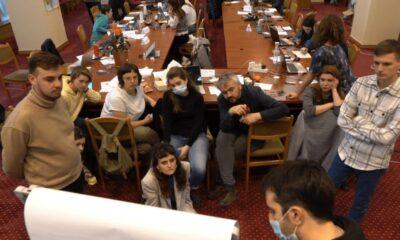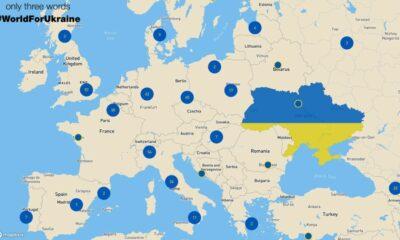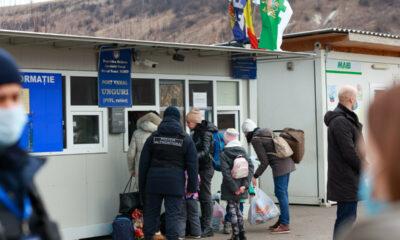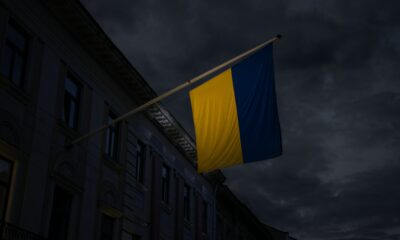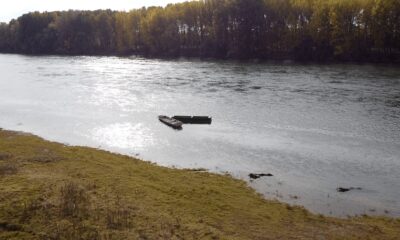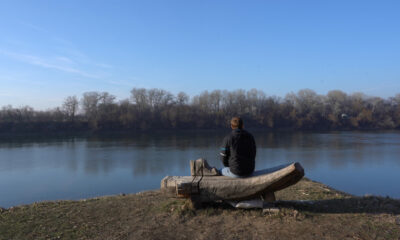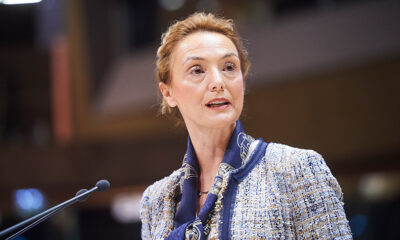Society
Titanic: How can a disastrous ship be celebrated?
Reading Time: 4 minutesMore than 1,500 people died when the Titanic sank. So why is the centenary of its launch being proudly celebrated in Northern Ireland, asks Tom de Castella.
More than 1,500 people died when the Titanic sank. So why is the centenary of its launch being proudly celebrated in Northern Ireland, asks Tom de Castella.
No other ship comes close to rivalling the gigantic shadow cast by the Titanic. A hundred years after its completion, it’s still the most iconic vessel to have set sail.
Its tragic maiden voyage has become shorthand for catastrophic hubris – the "unsinkable" ship that hit an iceberg and sank, causing the deaths of 1,503 passengers and crew. And yet in one corner of the UK, the Titanic is a byword not for disaster but a source of pride and nostalgia.
When its hull was launched at Belfast’s Harland and Wolff shipyard on 31 May 1911, it was the largest ship in the world, measuring 886ft (270m) long.
And in Northern Ireland that’s where the story ends, says Mick Fealty, editor of the news site Slugger O’Toole.
Rather than a maritime disaster, the Titanic is an engineering triumph. There’s a common Belfast joke, says the Irish writer Ruth Dudley Edwards, that taps into this feeling: "It was fine when it left us."
Behind the joking there’s a serious point, Fealty says. The shipyards in those days employed tens of thousands of workers while Belfast also had the world’s largest rope works and the huge textile machinery firm Mackies.
"The pride is about looking back to the golden days. The Titanic was the pinnacle of Belfast’s industrial glory," he says. This was in the days before partition when the majority Protestant city wore industrialisation as a badge of pride, differentiating itself from the agrarian, Catholic and rural south.
"Its industrialism was a real exception on the island of Ireland. Dublin was Edinburgh to Belfast’s Glasgow," says Fealty.
Not only that, its industrial might made Belfast a crucial partner in the British empire, says Jonathan Tonge, professor of politics at Liverpool University. "Many northern Irish Protestants say the empire was built on the Northern Irish ship building industry."
Archive film of Titanic in Belfast lough before her distinctive funnels were fitted
Dudley Edwards, author of The Faithful Tribe, about the Orange Order, says the Titanic is a link to a time when the Protestant working class built things.
East Belfast, where the shipyards were located, was staunchly unionist.
Contrary to legend, Catholic workers were involved in building the Titanic. It wasn’t until 1920 that Catholics were forced out of the shipyards en masse. But they had been a minority in a mainly Protestant workforce, and were typically in unskilled roles.
Under the effective segregation of the workforce, many skilled industrial jobs were reserved for the Protestant working class.
Catholic communities without such guaranteed industrial jobs encouraged their children to better themselves through education, Dudley Edwards says. But protestant east Belfast, where the shipyards were located, relied on their privileged access to industrial jobs.
"It’s all gone now. Those communities are now in a pretty terrible state," says Dudley Edwards. "Everyone in this community is very nostalgic about it."
The achievement of building the liner has not always been celebrated by everybody.
There was hostility to the Titanic legacy from Catholics, says Liam Kennedy, professor of history at Queen’s University Belfast. The fact that most of those who worked on it were Protestant was significant. But at a deeper level it was a rejection of the industrial achievements of east Belfast’s Protestant business class and workers, he says.
Prof Kennedy remembers how he first heard about the Titanic at school in County Tipperary, in the Republic of Ireland, during the early 1960s.
"The schoolmaster gave us the shipping number of the Titanic and said if you look at in the mirror it says ‘No Pope’. And I remember it really did look like that."
Prof Jonathan Moore, lecturer in Irish politics at London Metropolitan University, recalls the experience of an American student who recently visited Belfast’s Titanic exhibition.
"She’d gone to the Falls Road and was talking to some Sinn Fein supporters about how brilliant the exhibition was. One of them turned to her and said ‘Excuse me, that’s not part of our history’."
There are some who might wonder if the celebration of a ship associated with such loss of life is "baffling and bizarre", argues Prof Tonge. "Here’s a ship that took three years to build and two-and-a-half hours to sink. Yet 100 years later people are celebrating it. It’s jaw dropping."
Far from an engineering triumph the ship’s design was flawed. Paul Louden-Brown, vice president of the Titanic Historical Society, has written of how the design was a clumsy scaled-up version of smaller vessels and ignored the cutting-edge technology of Cunard’s liners.
And the builders’ claim that it was "practically unsinkable" had totally ignored the effect of an iceberg colliding with the side of the hull.
But you won’t hear that side of the story much in Belfast, notes Dudley Edwards.
In the long run that might be for the best. The ship’s fame has spawned the Titanic Quarter, a £7bn development which began in 2006 to turn the old shipyards into a mile-long waterfront of shops, offices and bars.
"They’re trying to give status to an area and pay homage to its history before it’s forgotten. And put something on there that’s aspirational and looking to the future," says Fealty.
Over the years the gruesome history has been rebranded into a global franchise and never more successfully than in James Cameron’s 1997 blockbuster starring Leonardo DiCaprio and Kate Winslet.
The film, which was the highest grossing movie until Avatar leap-frogged it in 2010, is due to be re-released for the centenary of the ship’s sinking next year.
And who can blame Northern Ireland for trying to offer a different story to tourists than the Peace Walls and bloody history of the Troubles, says Fealty. "If we’re famous for where that ship came from then that’s no bad thing. The story we’ve been telling the world for the last 40 years is a much worse one."
Society
“They are not needy, but they need help”. How Moldovan volunteers try to create a safe environment for the Ukrainian refugees
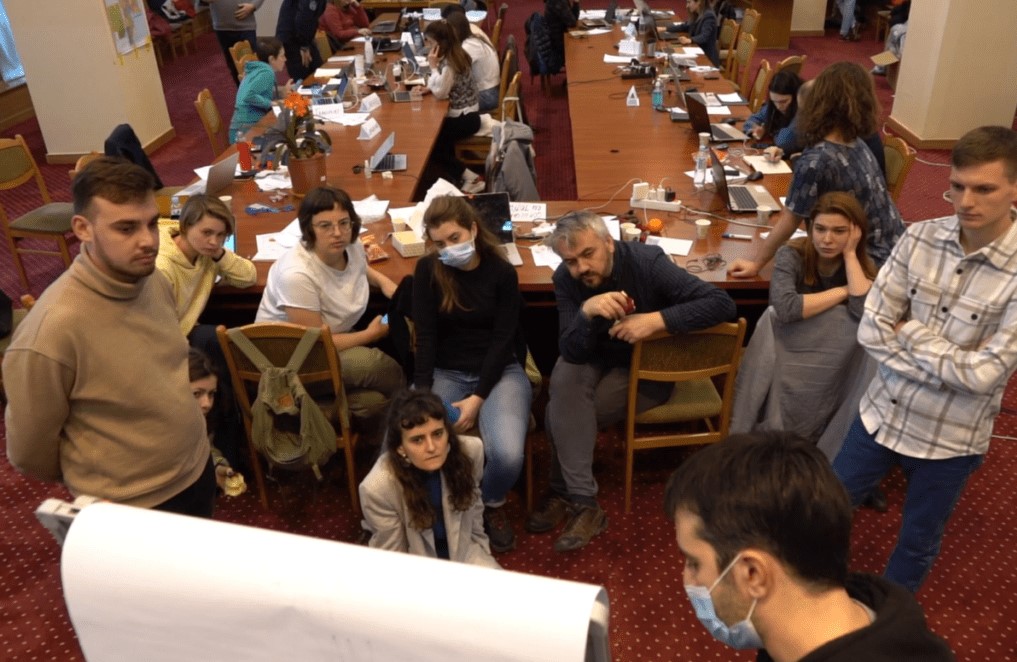
At the Government’s ground floor, the phones ring constantly, the laptop screens never reach standby. In one corner of the room there is a logistics planning meeting, someone has a call on Zoom with partners and donors, someone else finally managed to take a cookie and make some coffee. Everyone is exhausted and have sleepy red eyes, but the volunteers still have a lot of energy and dedication to help in creating a safe place for the Ukrainian refugees.
“It’s like a continuous bustle just so you won’t read the news. You get home sometimes and you don’t have time for news, and that somehow helps. It’s a kind of solidarity and mutual support,” says Vlada Ciobanu, volunteer responsible for communication and fundraising.
The volunteers group was formed from the very first day of war. A Facebook page was created, where all types of messages immediately started to flow: “I offer accommodation”, “I want to help”, “I want to get involved”, “Where can I bring the products?”, “I have a car and I can go to the customs”. Soon, the authorities also started asking for volunteers’ support. Now they all work together, coordinate activities and try to find solutions to the most difficult problems.
Is accommodation needed for 10, 200 or 800 people? Do you need transportation to the customs? Does anyone want to deliver 3 tons of apples and does not know where? Do you need medicine or mobile toilets? All these questions require prompt answers and actions. Blankets, sheets, diapers, hygiene products, food, clothes – people bring everything, and someone needs to quickly find ways of delivering them to those who need them.
Sometimes this collaboration is difficult, involves a lot of bureaucracy, and it can be difficult to get answers on time. “Republic of Moldova has never faced such a large influx of refugees and, probably because nobody thought this could happen, a mechanism of this kind of crisis has not been developed. Due to the absence of such a mechanism that the state should have created, we, the volunteers, intervened and tried to help in a practical way for the spontaneous and on the sport solutions of the problems,” mentions Ecaterina Luțișina, volunteer responsible for the refugees’ accommodation.
Ana Maria Popa, one of the founders of the group “Help Ukrainians in Moldova/SOS Українці Молдовa” says that the toughest thing is to find time and have a clear mind in managing different procedures, although things still happen somehow naturally. Everyone is ready to intervene and help, to take on more responsibilities and to act immediately when needed. The biggest challenges arise when it is necessary to accommodate large families, people with special needs, for which alternative solutions must be identified.
Goods and donations
The volunteers try to cope with the high flow of requests for both accommodation and products of all kinds. “It came to me as a shock and a panic when I found out that both mothers who are now in Ukraine, as well as those who found refuge in our country are losing their milk because of stress. We are trying to fill an enormous need for milk powder, for which the demand is high and the stocks are decreasing”, says Steliana, the volunteer responsible for the distribution of goods from the donation centers.
Several centers have been set up to collect donations in all regions of Chisinau, and volunteers are redirecting the goods to where the refugees are. A system for processing and monitoring donations has already been established, while the volunteer drivers take over the order only according to a unique code.
Volunteers from the collection centers also do the inventory – the donated goods and the distributed goods. The rest is transported to Vatra deposit, from where it is distributed to the placement centers where more than 50 refugees are housed.
When they want to donate goods, but they don’t know what would be needed, people are urged to put themselves in the position of refugees and ask themselves what would they need most if they wake up overnight and have to hurriedly pack their bags and run away. Steliana wants to emphasise that “these people are not needy, but these people need help. They did not choose to end up in this situation.”
Furthermore, the volunteer Cristina Sîrbu seeks to identify producers and negotiate prices for products needed by refugees, thus mediating the procurement process for NGOs with which she collaborates, such as Caritas, World Children’s Fund, Polish Solidarity Fund, Lifting hands, Peace Corps and others.
One of the challenges she is facing now is the identifying a mattress manufacturer in the West, because the Moldovan mattress manufacturer that has been helping so far no longer has polyurethane, a raw material usually imported from Russia and Ukraine.
Cristina also needs to find solutions for the needs of the volunteer groups – phones, laptops, gsm connection and internet for a good carrying out of activities.
Hate messages
The most difficult thing for the communication team is to manage the hate messages on the social networks, which started to appear more often. “Even if there is some sort of dissatisfaction from the Ukrainian refugees and those who offer help, we live now in a very diverse society, there are different kind of people, and we act very differently under stress,” said Vlada Ciobanu.
Translation by Cătălina Bîrsanu
Important
#WorldForUkraine – a map that shows the magnitude of the world’s actions against Russian aggression

The international community and volunteers from all over te world have launched #WorldForUkraine as a platform that shows the magnitude of the world’s actions against the Russian aggression. In a digital world – it is an interactive map of public support of Ukrainians under the hashtag #WorldForUkraine – rallies, flash mobs, protests around the world. In the physical dimension – it is your opportunity to take to the streets and declare: “No to Putin’s aggression, no to war.”
„Today, along with the political and military support, emotional connection with the civilized world and truthful information are extremely important for Ukraine. The power to do it is in your hands. Join the #WorldForUkraine project and contribute to the victorious battle against the bloodshed inflicted on Ukraine by the aggression of the Russian Federation”, says the „about the project” section of the platform.
Go to the streets — Tell people — Connect and Unite — Become POWERFUL
Volunteers have launched #WorldForUkraine as a platform that shows the magnitude of the world’s actions against Russian aggression. In digital world – it is an INTERACTIVE MAP of public support of Ukrainians worldforukraine.net under the hashtag #WorldForUkraine – rallies, flash mobs, protests around the world. In the physical dimension – it is your opportunity to take to the streets and declare: “No to Putin’s aggression, no to war.” There you may find information about past and future rallies in your city in support of Ukraine. This is a permanent platform for Ukrainian diaspora and people all over the world concerned about the situation in Ukraine.
So here’s a couple of things you could do yourself to help:
* if there is a political rally in your city, then participate in it and write about it on social media with geolocation and the hashtag #WorldForUkraine
* if there are no rallies nearby, organize one in support of Ukraine yourself, write about it on social media with geolocation adding the hashtag #WorldForUkraine
The map will add information about gathering by #WorldForUkraine AUTOMATICALLY
Your voice now stronger THAN ever
All rallies are already here: https://worldforukraine.net
Important
How is Moldova managing the big influx of Ukrainian refugees? The authorities’ plan, explained
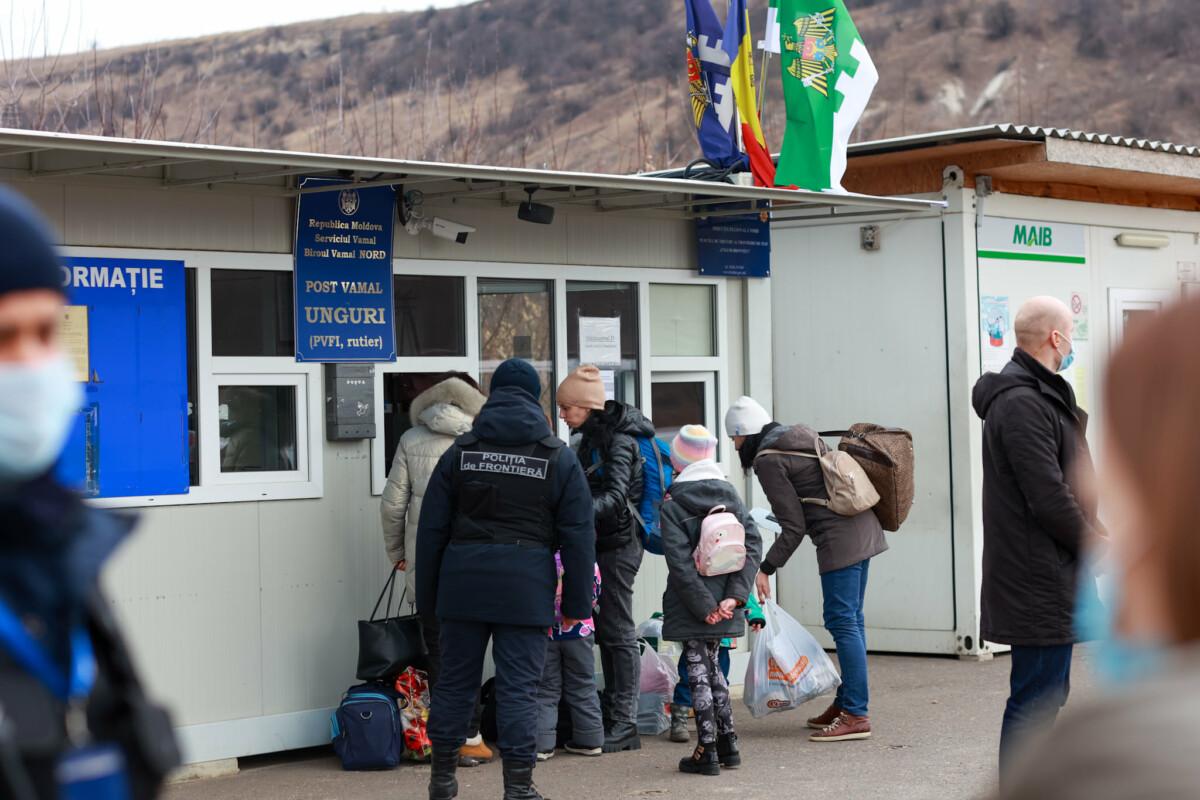
From 24th to 28th of February, 71 359 Ukrainian citizens entered the territory of Republic of Moldova. 33 173 of them left the country. As of this moment, there are 38 186 Ukrainian citizens in Moldova, who have arrived over the past 100 hours.
The Moldovan people and authorities have organized themselves quickly from the first day of war between Russia and Ukraine. However, in the event of a prolonged armed conflict and a continuous influx of Ukrainian refugees, the efforts and donations need to be efficiently managed. Thus, we inquired about Moldova’s long-term plan and the state’s capacity to receive, host, and treat a bigger number of refugees.
On February 26th, the Ministry of Labor and Social Protection of Moldova approved the Regulation of organization and functioning of the temporary Placement Center for refugees and the staffing and expenditure rules. According to the Regulation, the Centers will have the capacity of temporary hosting and feeding at least 20 persons, for a maximum of 3 months, with the possibility of extending this period. The Centers will also offer legal, social, psychological, and primary medical consultations to the refugees. The Center’s activity will be financed from budget allocations, under Article 19 of Provision no. 1 of the Exceptional Situations Commission from February 24th, 2022, and from other sources of funding that do not contravene applicable law.
The Ministry of Inner Affairs and the Government of Moldova facilitated the organization of the volunteers’ group “Moldova for Peace”. Its purpose is to receive, offer assistance and accommodation to the Ukrainian refugees. The group is still working on creating a structure, registering and contacting volunteers, etc. It does not activate under a legal umbrella.
Lilia Nenescu, one of the “Moldova for Peace” volunteers, said that the group consists of over 20 people. Other 1700 registered to volunteer by filling in this form, which is still available. The group consists of several departments:
The volunteers’ department. Its members act as fixers: they’re responsible for connecting the people in need of assistance with the appropriate department. Some of the volunteers are located in the customs points. “The Ministry of Inner Affairs sends us every day the list of the customs points where our assistance is needed, and we mobilize the volunteers”, says Lilia Nenescu.
The Goods Department manages all the goods donated by the Moldavian citizens. The donations are separated into categories: non-perishable foods and non-food supplies. The volunteers of this department sort the goods into packages to be distributed.
The Government intends to collect all the donations in four locations. The National Agency for Food Safety and the National Agency for Public Health will ensure mechanisms to confirm that all the deposited goods comply with safety and quality regulations.
The Service Department operates in 4 directions and needs the volunteer involvement of specialists in psychology, legal assistance (the majority of the refugees only have Ukrainian ID and birth certificates of their children); medical assistance; translation (a part of the refugees are not Ukrainian citizens).
According to Elena Mudrîi, the spokesperson of the Ministry of Health, so far there is no data about the number of Covid-19 positive refugees. She only mentioned two cases that needed outpatient medical assistance: a pregnant woman and the mother of a 4-day-old child.
The Accommodation Department. The volunteers are waiting for the centralized and updated information from the Ministry of Labor about the institutions offering accommodation, besides the houses offered by individuals.
The Transport Department consists of drivers organized in groups. They receive notifications about the number of people who need transportation from the customs points to the asylum centers for refugees.
The municipal authorities of Chișinău announced that the Ukrainian children refugees from the capital city will be enrolled in educational institutions. The authorities also intend to create Day-Care Centers for children, where they will be engaged in educational activities and will receive psychological assistance. Besides, the refugees from the municipal temporary accommodation centers receive individual and group counseling.
In addition to this effort, a group of volunteers consisting of Ana Gurău, Ana Popapa, and Andrei Lutenco developed, with the help of Cristian Coșneanu, the UArefugees platform, synchronized with the responses from this form. On the first day, 943 people offered their help using the form, and 110 people asked for help. According to Anna Gurău, the volunteers communicate with the Government in order to update the platform with the missing data.
Translation from Romanian by Natalia Graur


